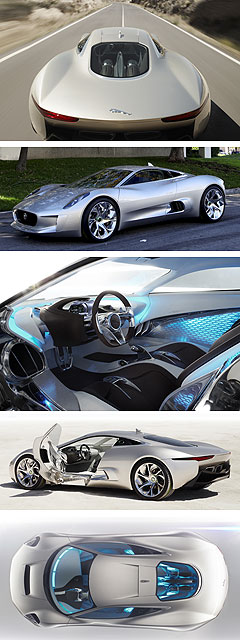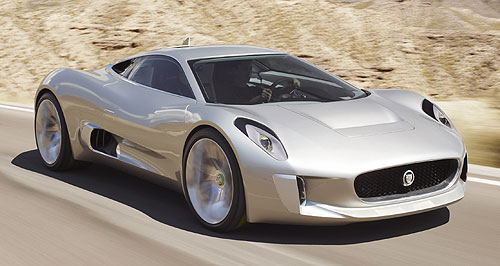Future models - Jaguar - C-X75Jaguar C-X75 hybrid supercar confirmed for OzBoost juice: The C-X75 will have a KERS-style energy boost function. Stunning C-X75 supercar will be built in right-hand-drive for Australia, says Jaguar7 Jun 2011 JAGUAR has confirmed its ground-breaking C-X75 hybrid supercar will be available in Australia. After initially stating the car would only be built in left-hand drive when the project was announced for production last month, the company has now made its position clear. “It was always going to be right-hand drive,” British-based Jaguar group engineering chief Bob Joyce told GoAuto at the XKR-S launch in Portugal this week. “It has to be. I want to be able to drive one,” he joked, before putting the confusion down to a communications mix-up. Jaguar Australia brand manager Kevin Goult said he was pleased to hear the C-X75 would be built in right-hand drive form when production starts in 2013, and confirmed the final product would meet all Australian Design Rules. “We'll be kicking off the homologation and certification activity to ensure that it can be registered in each state and will work with UK engineering to do so,” he said. “It’s encouraging that the car is going to be built in right-hand drive and I'm hopeful we'll have customers who want to purchase a C-X75.”  The door is now open for Australians to buy the most exclusive Jaguar ever produced but, as we’ve reported, local C-X75 customers will need to come up with at least $1 million to secure one of the 250 vehicles. The door is now open for Australians to buy the most exclusive Jaguar ever produced but, as we’ve reported, local C-X75 customers will need to come up with at least $1 million to secure one of the 250 vehicles.Jaguar is already taking expressions of interest and will begin taking firm deposits later this year. The C-X75 is shaping as an iconic car for Jaguar and the company is confident it will be faster than the road-going XJ220 racecar. The Ian Callum-designed super-coupe was presented as a futuristic concept at last year’s Paris motor show, but intense lobbying from potential customers led Jaguar to give it the green light for production. Mr Joyce told GoAuto he didn’t think the C-X75 would have been approved for production if Jaguar was still owned by Ford rather than its current custodian, India’s Tata Motors. “We never would have been able to do this unless we were with Tata,” he said. “There would have been too many forms and paperwork (under Ford management).” Asked if the ambitious project would be profitable, Mr Joyce said: “We won’t lose any money, we are confident this will make money.”“We will have no problem selling the 250 cars.” But Mr Joyce ruled out extending the production run. “No, 250 will be it. We can’t lead customers on by saying there will only be 250 and then extend that or release something else very similar.” While the Paris concept car ran a gas turbine that generated energy for its in-wheel motors, the production car will employ a high-revving 1.6-litre four-cylinder petrol engine, which is likely to be sourced or at least heavily developed by Williams. The Formula One team is switching to four-cylinder engines next year in line with new rules and team boss Frank Williams attended the C-X75 production announcement. Mr Joyce confirmed the super-hybrid would have some kind of energy boost system, like the Formula One-style Kinetic Energy Recovery System (KERS), with which drivers can call on extra electric energy. “There will be an on-demand element,” he said. The production model, which will be a direct rival for Porsche’s million-dollar upcoming 918 Spyder plug-in hybrid, will use two “very powerful” electric motors, for which energy will be stored in lithium-ion batteries. Mr Joyce would not comment on whether the hybrid system would recover energy from the petrol engine’s deceleration or whether Jaguar will use a flywheel hybrid system like that seen on Porsche’s 911 GT3 Hybrid racer. While it doesn’t currently have a hybrid model, Jaguar engineers do have experience with electric propulsion technology, having worked with MIRA, Lotus Cars and Caparo in a government-backed project to build a petrol-electric XJ sedan called Limo Green. Mr Joyce told GoAuto the C-X75 is well advanced as a 3D CAD model, although no psychical test mules had been constructed yet. He said the limited-run C-X75 project would be dramatically cheaper and faster to develop than a regular production model, partly because the company did not need to crash test as many vehicles as part of the homologation process. He said more than 100 cars would normally be built for testing and development, with 40 required for crash testing alone. As few as 12 test cars would likely be needed for the C-X75 development process, which will largely be completed using computer simulations. “We are using some very advanced computer simulations to develop the aerodynamics and the way these very complex electrical systems work together,” Mr Joyce said. Jaguar’s chief engineer said the C-X75’s development cost and time would also be reduced because traditional production tooling will not be required due to the low volume and the use of alternative materials including carbon-fibre. “The cost is going to be surprisingly less than a production program,” Mr Joyce said.  Read moreAll future models Alfa Romeo Alfa Romeo Abarth Abarth Audi Audi Aston Martin Aston Martin BMW BMW Bentley Bentley Chrysler Chrysler Chevrolet Chevrolet Dodge Dodge Citroen Citroen Ferrari Ferrari DS DS Ford Ford Fiat Fiat FPV FPV Foton Foton Haval Haval Great Wall Great Wall Honda Honda Holden Holden Hyundai Hyundai HSV HSV Isuzu Isuzu Infiniti Infiniti Jeep Jeep Jaguar Jaguar Lamborghini Lamborghini Kia Kia Lexus Lexus Land Rover Land Rover Mazda Mazda Maserati Maserati Mercedes-Benz Mercedes-Benz McLaren McLaren Mini Mini Nissan Nissan Mitsubishi Mitsubishi Peugeot Peugeot Opel Opel Proton Proton Porsche Porsche Renault Renault Ram Ram Saab Saab Rolls-Royce Rolls-Royce Smart Smart Skoda Skoda Subaru Subaru SsangYong SsangYong Tesla Tesla Suzuki Suzuki Toyota Toyota Volvo VolvoMotor industry news |
Click to shareJaguar modelsResearch Jaguar All future models Alfa Romeo Alfa Romeo Abarth Abarth Audi Audi Aston Martin Aston Martin BMW BMW Bentley Bentley Chrysler Chrysler Chevrolet Chevrolet Dodge Dodge Citroen Citroen Ferrari Ferrari DS DS Ford Ford Fiat Fiat FPV FPV Foton Foton Haval Haval Great Wall Great Wall Honda Honda Holden Holden Hyundai Hyundai HSV HSV Isuzu Isuzu Infiniti Infiniti Jeep Jeep Jaguar Jaguar Lamborghini Lamborghini Kia Kia Lexus Lexus Land Rover Land Rover Mazda Mazda Maserati Maserati Mercedes-Benz Mercedes-Benz McLaren McLaren Mini Mini Nissan Nissan Mitsubishi Mitsubishi Peugeot Peugeot Opel Opel Proton Proton Porsche Porsche Renault Renault Ram Ram Saab Saab Rolls-Royce Rolls-Royce Smart Smart Skoda Skoda Subaru Subaru SsangYong SsangYong Tesla Tesla Suzuki Suzuki Toyota Toyota Volvo VolvoMotor industry news |















Facebook Twitter Instagram